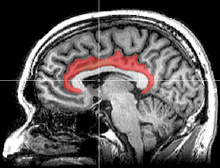Cingulate cortex
[3][4] The combination of these three functions makes the cingulate gyrus highly influential in linking motivational outcomes to behavior (e.g. a certain action induced a positive emotional response, which results in learning).The anterior cingulate cortex receives primarily its afferent axons from the intralaminar and midline thalamic nuclei (see thalamus).[12] Injecting wheat germ agglutinin and horseradish peroxidase conjugate into the anterior cingulate gyrus of cats, revealed that the anterior cingulate gyrus has reciprocal connections with the rostral part of the thalamic posterior lateral nucleus and rostral end of the pulvinar.[17] Haznedar et al. (2004) studied metabolic rate of glucose in anterior and posterior cingulate gyrus in people with schizophrenia, schizotypal personality disorder (SPD) and compared them with a control group.[18] A study of the volume of the gray and white matter in the anterior cingulate gyrus in people with schizophrenia and their healthy first and second degree relatives revealed no significant difference in the volume of the white matter in the people with schizophrenia and their healthy relatives.[19] Fujiwara et al. (2007) did an experiment in which they correlated the size of anterior cingulate gyrus in people with schizophrenia with their functioning on social cognition, psychopathology and emotions with control group.The smaller the size of anterior cingulate gyrus, the lower was the level of social functioning and the higher was the psychopathology in the people with schizophrenia.The anterior cingulate gyrus was found to be bilaterally smaller in people with schizophrenia as compared with control group.No difference in IQ tests and basic visuoperceptual ability with facial stimuli was found between people with schizophrenia and the control.[18][19] Healthy females have larger rostral anterior cingulate gyrus than males, this sex difference in size is absent in people with schizophrenia.[22] While the volume of gray matter is smaller, the size of the lateral and third ventricles is larger in people with schizophrenia.[26] The limbic lobe was separated from the remainder of the cortex by Broca for two reasons: first because it is not convoluted, and second because the gyri are directed parasagittally (contrary to the transverse gyrification).



Cerebral cortexArteryAnterior cerebralSuperior sagittal sinusNeuroNamesNeuroLexAnatomical terms of neuroanatomyCoronal sectioncorpus callosumcingulate sulcuslimbic lobethalamusneocortexentorhinal cortexcingulumlimbic systemdepressionschizophreniaexecutive functioncerebral cytoarchitectonicsBrodmann areasMicrographspindle neuronsLFB stainAnterior cingulate cortexConstantin von EconomoBrodmann area 25genu of the corpus callosumagranularsulcalintralaminarmidlinesubiculumneural circuitPapez circuitPosterior cingulate cortexventral anterior nucleusventral lateral nucleuswheat germ agglutininhorseradish peroxidasepulvinarschizotypal personality disorderdepressive disordersdeep-brain stimulation therapystrokepost-stroke depressionBroca (1878)gyrificationBrodmann (1909)Oxford English DictionaryOxford University PressBrainMaps projectWayback Machinehuman brainFrontal lobePrefrontalSuperior frontal gyrusMiddle frontal gyrusInferior frontal gyrusPars orbitalisBroca's areaPars opercularisPars triangularisSuperior frontal sulcusInferior frontal sulcusPrecentralPrecentral gyrusPrecentral sulcusMedial frontal gyrusParaterminal gyrusParaolfactory areaStraight gyrusOrbital gyriOrbitofrontal cortexVentromedial prefrontal cortexSubcallosal areaOlfactory sulcusOrbital sulcusParacentral lobuleParacentral sulcusPrimary motor cortexPremotor cortexSupplementary motor areaSupplementary eye fieldFrontal eye fieldsParietal lobeSuperior parietal lobuleInferior parietal lobuleSupramarginal gyrusAngular gyrusParietal operculumIntraparietal sulcusPrecuneusMarginal sulcusPostcentral gyrusPrimary somatosensory cortex3, 1 and 2Secondary somatosensory cortexPosterior parietal cortexOccipital lobeOccipital gyriLateral occipital gyrusLunate sulcusTransverse occipital sulcusVisual cortexCuneusLingual gyrusCalcarine sulcusTemporal lobeTransverse temporal gyrusAuditory cortex41 and 42Superior temporal gyrusWernicke's areaPlanum temporaleSuperior temporal sulcusMiddle temporal gyrusOccipitotemporal sulcusFusiform gyrusMedial temporal lobeInferior temporal sulcusInferior temporal gyrusInterlobarsulci/fissuresCentral (frontal+parietal)Lateral (frontal+parietal+temporal)Parieto-occipital